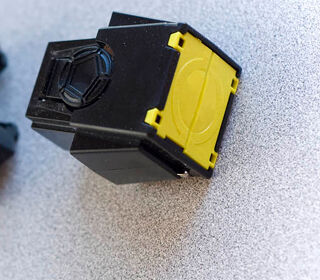
Blog

MA Criminology student Sally Browne was given the opportunity to represent Birmingham City University at a Taser Training event arranged by West Midlands Police.
“As a student, I had the unique opportunity to witness the training and assessment process for police officers seeking authorization to carry a taser. On the second day of their training, we were introduced to the officers who had already undergone theoretical and scientific instruction on the taser equipment, and their assessment day was just around the corner.
The instructors explained that we would observe the trainees using the taser in various scenarios, offering constructive feedback and evaluating their adherence to the National Decision Model (NDM). The NDM requires officers to justify their taser usage in their reports, as it's considered a use of force.
We were divided into pairs to observe groups of trainees facing realistic scenarios, ranging from confronting individuals wielding dangerous weapons to handling a self-harmer and resolving disputes between neighbours. The professionalism and compassion displayed by the officers, especially in the sensitive suicide scenario, left a lasting impression.
After each scenario, the taser candidates received feedback and were advised on improving their performance. They were also quizzed on the NDM sections and the relevant legislation they'd need for their reports, as well as contingency plans for real-life situations.
This experience shed light on the rigorous training and accountability that taser officers must endure. It emphasized the scrutiny they face from colleagues, superiors, and the public. It also highlighted the practical implementation of the NDM and legislation in daily police work, emphasizing the responsibility and skills required for taser certification.
The taser, while considered a firearm, was shown to be a useful tool for police. It's generally not life-threatening and is often the first option officers turn to, followed by PAVA spray and batons as a last resort. This hierarchy takes into account the temporary incapacitation of suspects and the potential risks associated with other tools. The tasers role in protecting officers, the public, and even the individuals subjected to it, such as those in self-harming situations, became evident. Stringent training and oversight help prevent improper use, ensuring public safety.
The highlight of the day was an up-close look at the taser unit, its components, and how officers handle it. We were impressed by the technology's ability to automatically activate body-worn cameras when the taser is drawn, providing multiple angles of incidents for accountability.
The instructor demonstrated the process of "reenergizing" discharged probes, explaining that this can be done as many times as necessary but must be justified later in reports. With only two cartridges per taser, officers must avoid mistakes in their assessments to ensure they have means of protection.
The training also covered situations involving individuals with heart conditions, children, and dangerous animals. The officers prioritize public and officer safety over the legally recognized threat, using the taser when justified, regardless of age or the target's identity. Throughout the day, the importance of safety was emphasized, including the use of protective glasses during demonstrations.
I'd like to express my gratitude to Jonathan Jackson for this invaluable experience, along with Beth Davies-Smith, the BCU Criminology and Policing department, the Faculty of Social Sciences and the West Midlands Police personnel who made this event possible. Best of luck to the officers as they continue their careers and use of the taser.”